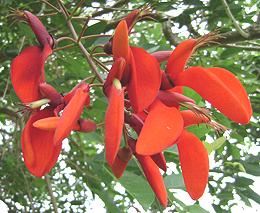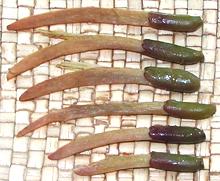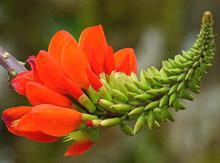 [Genus Erithina of Family Fabaceae]
[Genus Erithina of Family Fabaceae]
Coral Trees are found worldwide. They are often planted as decoratives, to replenish nitrogen, to shade other crops, and as support for vanilla bean vines. They are generally quite toxic, containing strong alkaloids, but some parts of some are eaten. Other parts of several are used medicinally. Seeds of some are used as rat poison, and bark as fish poison. The part most eaten is the flower, which is slightly narcotic and sleep inducing. Young leaves and buds are also sometimes eaten, but the beans of only one are edible. Photo of Erythrina fusca by Tau'olunga distributed under license Creative Commons Attribution-ShareAlike v3.0 Unported
More on Beans, Peas & Lentils
 [Aposhi, Chilicote, Colorin, Peonia, Machete, Coral Bean; K'ante
(Lacandon); Tzinacancuahuitl (Aztec); Erithina berterona]
[Aposhi, Chilicote, Colorin, Peonia, Machete, Coral Bean; K'ante
(Lacandon); Tzinacancuahuitl (Aztec); Erithina berterona]
This tree is native to Central America and some of the Caribbean islands, particularly Cuba, and has been cultivated and naturalized in Panama. The name "Pito", whistle, comes from boys using the flowers to make whistles. In Guatemala and El Salvador, the flower buds, picked before they turn red and open, are used as a vegetable, similarly to string beans. Young leaves and soft young twigs can are eaten, but are not particularly tasty. In other parts of Central America, the young flowers and shoots are added to soups, usually bean soups, and other food preparations as a vegetable. They have a combination of dark floral and dark vegetable tastes, and stand up well to wet cooking.
Eating a lot of the flower buds has a sedative effect, and young leaves and twigs may be simmered to make a sedative tea. The seeds are much more powerful, and the usual dosage is 1/4 to 1/2 seed. Crushed branches are used as a fish poison. The photo specimens were from Guatemala, purchased frozen from a large Hispanic market in Los Angeles (Burbank) for 2016 US $3.99 for 6 ounces, or $10.64 per pound. The top specimen in the photo was 2-7/8 inches long.
Other Coral Flowers used similarly are:
 [Frijol mompás" (Venezuela); Pisonay, Pajuro, Sachaporoto del
basul, Poroto del sacha (Bolivia, Peru, Argentina); Chachafruto,
Balú, Baluy, Sachaporoto (Colombia); Guato (Ecuador);
Erithina berterona]
[Frijol mompás" (Venezuela); Pisonay, Pajuro, Sachaporoto del
basul, Poroto del sacha (Bolivia, Peru, Argentina); Chachafruto,
Balú, Baluy, Sachaporoto (Colombia); Guato (Ecuador);
Erithina berterona]
This tree is native to the Andean region from western Venezuela to
southern Bolivia. It is the only Coral Tree that produces beans
non-toxic enough to be edible. Unripe pods can be eaten, but the
beans are more popular as food. Pods, which can be up to 26 inches
long have 6 seeds, up to 2.5 inches long and up to 1.1 ounces each.
A 20 year old tree can produce more than 400 pounds of seeds a year,
with the crop coming in earlier than most other crops. The beans are
too watery to dry, so are used fresh, boiled or fried for about 45
minutes. After boiling, they can be dried and ground into flour.
Cooked beans can be used in soups, salads and other dishes. Usage
is not yet widespread, but Andean governments are promoting it in
their regions.
Photo by Alejandro Bayer Tamayo distributed under
license Creative Commons
Attribution ShareAlike v2.0 Generic